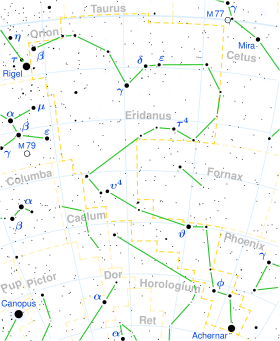Delta Eridani
Delta Eridani (δ Eri, δ Eridani) is a 3.54 magnitude star in the constellation of Eridanus. It is sometimes called Rana.[11] Rana means "the frog" in Latin, but derivation of this name is uncertain.
 | |
| Observation data Epoch J2000 Equinox J2000 | |
|---|---|
| Constellation | Eridanus |
| Right ascension | 03h 43m 14.90s[1] |
| Declination | –09° 45′ 48.2″[1] |
| Apparent magnitude (V) | 3.51 - 3.56[2] |
| Characteristics | |
| Spectral type | K0 IV[3] |
| U−B color index | +0.69[4] |
| B−V color index | +0.92[4] |
| Variable type | RS CVn[2] |
| Astrometry | |
| Radial velocity (Rv) | –6.28 ± 0.09[5] km/s |
| Proper motion (μ) | RA: –93.16 ± 0.29[1] mas/yr Dec.: +743.64 ± 0.22[1] mas/yr |
| Parallax (π) | 110.61 ± 0.29[1] mas |
| Distance | 29.49 ± 0.08 ly (9.04 ± 0.02 pc) |
| Absolute magnitude (MV) | 3.77[6] |
| Details | |
| Mass | 1.33 ± 0.07[7] M☉ |
| Radius | 2.327 ± 0.029[7] R☉ |
| Luminosity | 3.00 ± 0.12[7] L☉ |
| Surface gravity (log g) | 3.9[8] cgs |
| Temperature | 5,055[9] K |
| Metallicity [Fe/H] | 0.13[9] dex |
| Rotational velocity (v sin i) | 1.0[6] km/s |
| Age | 6.194[10] Gyr |
| Other designations | |
Rana, δ Eridani, 23 Eridani, HD 23249, HR 1136, BD−10° 728, GCTP 788, GJ 150, LHS 1581, HIP 17378. | |
| Database references | |
| SIMBAD | data |
Structure
This star is relatively near to the Sun, at a measured distance of about 29 light years. It is a variable star with a small visual amplitude, only changing brightness between magnitudes 3.51 and 3.56. It is a suspected RS Canum Venaticorum variable, but this is still uncertain.[2]
δ Eridani is a subgiant star that has exhausted its core hydrogen. This has caused the star to expand and become cooler than a comparable main sequence star. Its physical properties show it to be near the end of the subgiant branch and about to join the red giant branch.[10]
Names
In Chinese, 天苑 (Tiān Yuàn), meaning Celestial Meadows, refers to an asterism consisting of δ Eridani, γ Eridani, π Eridani, ε Eridani, ζ Eridani, η Eridani, π Ceti, τ1 Eridani, τ2 Eridani, τ3 Eridani, τ4 Eridani, τ5 Eridani, τ6 Eridani, τ7 Eridani, τ8 Eridani and τ9 Eridani.[12] Consequently, the Chinese name for δ Eridani itself is 天苑三 (Tiān Yuàn sān, English: the Third Star of Celestial Meadows.)[13]
See also
- List of star systems within 25–30 light-years
- Delta Eridani in fiction
References
- van Leeuwen, F. (2007). "HIP 17378". Hipparcos, the New Reduction. Retrieved 2009-12-11.
- Samus, N. N.; Durlevich, O. V.; et al. (2009). "VizieR Online Data Catalog: General Catalogue of Variable Stars (Samus+ 2007-2013)". VizieR On-line Data Catalog: B/GCVS. Originally Published in: 2009yCat....102025S. 1: B/gcvs. Bibcode:2009yCat....102025S.
- Spinrad, Hyron; Taylor, Benjamin J. (1969). "Scanner Abundance Studies. I. an Investigation of Supermetallicity in Late-Type Evolved Stars". Astrophysical Journal. 157: 1279. Bibcode:1969ApJ...157.1279S. doi:10.1086/150154.
- Mermilliod, J.-C. (1986). "Compilation of Eggen's UBV data, transformed to UBV (unpublished)". Catalogue of Eggen's UBV Data. Bibcode:1986EgUBV........0M.
- Jofré, E.; Petrucci, R.; Saffe, C.; Saker, L.; de la Villarmois, E. Artur; Chavero, C.; Gómez, M.; Mauas, P. J. D. (2015). "Stellar parameters and chemical abundances of 223 evolved stars with and without planets". Astronomy & Astrophysics. 574: A50. arXiv:1410.6422. Bibcode:2015A&A...574A..50J. doi:10.1051/0004-6361/201424474. S2CID 53666931.
- Pizzolato, N.; Maggio, A.; Sciortino, S. (September 2000), "Evolution of X-ray activity of 1-3 Msun late-type stars in early post-main-sequence phases", Astronomy and Astrophysics, 361: 614–628, Bibcode:2000A&A...361..614P
- Bruntt, H.; et al. (July 2010), "Accurate fundamental parameters for 23 bright solar-type stars", Monthly Notices of the Royal Astronomical Society, 405 (3): 1907–1923, arXiv:1002.4268, Bibcode:2010MNRAS.405.1907B, doi:10.1111/j.1365-2966.2010.16575.x, S2CID 118495267
- Morell, O.; Kallander, D.; Butcher, H. R (1999). "The age of the Galaxy from thorium in G dwarfs, a re-analysis". Astronomy and Astrophysics. 259 (2): 543–548. Bibcode:1992A&A...259..543M.
- Piau, L.; et al. (February 2011), "Surface convection and red-giant radius measurements", Astronomy and Astrophysics, 526: A100, arXiv:1010.3649, Bibcode:2011A&A...526A.100P, doi:10.1051/0004-6361/201014442, S2CID 118533297
- Thévenin, F.; Kervella, P.; Pichon, B.; Morel, P.; Di Folco, E.; Lebreton, Y. (2005). "VLTI/VINCI diameter constraints on the evolutionary status of δ Eri, ξ Hya, η Boo". Astronomy and Astrophysics. 436 (1): 253. arXiv:astro-ph/0501420. Bibcode:2005A&A...436..253T. doi:10.1051/0004-6361:20042075. S2CID 118169489.
- Bečvář, A. (1951). Atlas Coeli Skalnaté Pleso II - Katalog 1950.0. Přírodovědecké Vydavatelstrí. p. 277. Retrieved 27 May 2019.
- (in Chinese) 中國星座神話, written by 陳久金. Published by 台灣書房出版有限公司, 2005, ISBN 978-986-7332-25-7.
- (in Chinese) 香港太空館 - 研究資源 - 亮星中英對照表 Archived January 30, 2011, at the Wayback Machine, Hong Kong Space Museum. Accessed on line November 23, 2010.
Sources
- Fisher, G. F., Hall, D. S., Henry, G. W., Landis, H. J., Renner, T. R., and Shore, S. N., "Delta Eridani: A Very Bright New Variable Star,", Information Bulletin on Variable Stars, No. 2259, 1983.
- Eaton, J. A.; Poe, C. H., "Limits on the Variability of epsilon Eridani and delta Eridani", Information Bulletin on Variable Stars, 2712, 1985.
External links
- Jim Kaler's page on Rana
- SolStation entry
- nStars entry